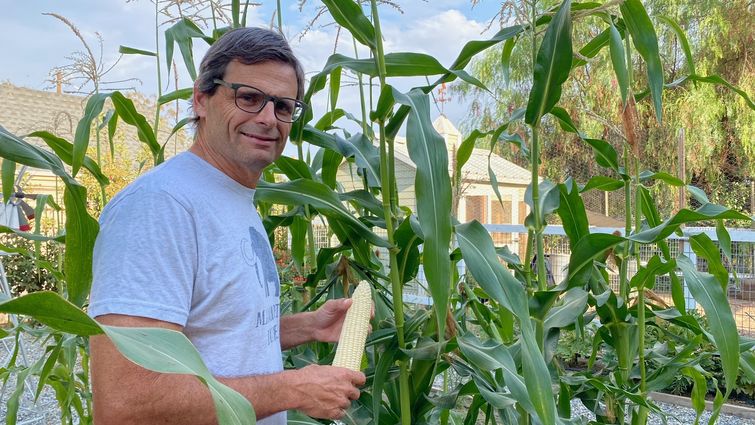

Cardiologist Dr. Anthony Hilliard says growing his own fruits and vegetables helps him live by the "eat to live" philosophy.
The food we eat and how we eat it significantly impacts our health — especially heart health. Framing a healthy relationship to food using some basic guiding principles can therefore play a vital role in improving heart health, says Anthony Hilliard, MD, chief of cardiology at Loma Linda University International Heart Institute.
"Eat to live" provides a practical framework when making heart-healthy lifestyle changes regarding food. Eating to live involves treating food like it is fuel for the body, Hilliard says. Often, the inverse "live to eat" approach signals that a disproportionate amount of pleasure becomes vested chiefly or exclusively in the eating experience itself, which Hilliard says typically gives way to unhealthy choices.
The food you should be choosing to put in your body should be so that your body runs optimally well.Dr. Anthony Hilliard
Instead, eating to live creates a means of optimizing the body to enjoy many additional life opportunities, such as being physically active. Hilliard says there are ways to harmonize both live to eat and eat to live in your life.
“The food you should be choosing to put in your body should be so that your body runs optimally well,” he says. “You can feel great joy from eating while also ensuring your body finds joy and value in what you’re giving it. It's a win-win situation when you derive pleasure from doing both.”
The formation of plaque in the vasculature, which affects heart function, is rooted in food choices, he says — and it is essential to understand what components make food unhealthy and how it affects the body.

Hilliard says that foods with high sugar content, also known as simple carbohydrates, play a significant causal role in weight gain and obesity, one of the major contributing factors to heart disease. In response to high-sugar foods, the body initiates a surge in insulin production that stores the sugar as fat. The sugar rush and drastic uptick in insulin prevent muscles and organs from deriving nutritional value because sugar is stored as fat.
Instead, complex carbohydrates that contain fiber present a healthier alternative — brown rice instead of white rice, or wheat bread with nuts versus white bread. It takes longer for the body to digest the fiber in complex carbohydrates. As a result, sugars circulate more slowly in the bloodstream, and the body avoids a sugar spike and insulin surge that creates fat.
For those seeking to optimize their heart health and adopt the eat to live and live to eat approach, Hilliard recommends following some basic steps that will take you a long way.
Eat fresh foods, or, in other words, avoid eating foods that do not expire. These tend to be processed foods with high sugar, including unhealthy preservatives like corn syrup.
“If you were to leave something out on the counter and it wouldn’t go bad over time, then that’s a sign not to eat the food,” Hilliard says.
Include a variety of colors on your plate. “If you look at your plate and everything is the same color, then there is probably not enough variety on your plate,” Hilliard says.
One helpful way to visualize a balanced and colorful meal is by sectioning the plate. One-half of the plate should hold vegetables and fruits. A quarter of the plate should be dedicated to proteins, and the other quarter dedicated to leafy greens and legumes. If you do this, chances are you guarantee various colors on the plate, Hilliard says.
Control the pacing and portion of food intake. Hilliard recommends imagining dividing your stomach into three layers. When you eat, the bottom layer of the stomach should be food, topped by a middle layer of water or fluids. The upper third layer of the stomach should be air, or unused. "The goal isn't to get full," he says, "it's to get enough food or fuel to do an activity."

Based on this approach, Hilliard says you should be able to exercise after you eat. If you feel that you can't, you've probably eaten too much. "If you like something so much, have it every meal, but just have a little bit,” he says. “If you want a second piece of lasagna, just wait three hours.”
Sticking to these basic principles offers a strong foundation for building good heart health and overall heart health, Hilliard says. From there, he says you can continue building off the pillars and customize your approach to what you’ve found works best for your body.
Eat to live and live to eat is not considered a diet, which implies that it is temporary, Hilliard says. Instead, he recommends thinking of this approach to food and nutrition as a “life journey" that will require constant adjustments as your body evolves with it.
LLU’s Cardiopulmonary Rehabilitation program provides further guidance about building good habits around nutrition for those who have experienced a cardiac event or procedure or are living with heart disease. Visit the International Heart Institute online or call 1-800-468-5432 to learn more about cardiovascular care services offered at Loma Linda University Health.
